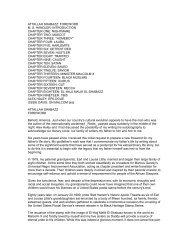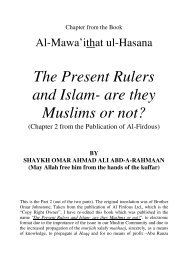You also want an ePaper? Increase the reach of your titles
YUMPU automatically turns print PDFs into web optimized ePapers that Google loves.
Communist Party in 1848), and were active in <strong>the</strong> Communist<br />
Revolution of 1848.<br />
Before taking leave of <strong>the</strong> Frankist elite, we should point out<br />
that David Friedlander (1750-1834), of Moses Mendelssohn's<br />
circle, was also prominent in <strong>the</strong> Reform movement and,<br />
interestingly enough, in 1799, prior <strong>to</strong> <strong>the</strong> movement's<br />
creation, he wrote an anonymous letter <strong>to</strong> a Pas<strong>to</strong>r Teller on<br />
behalf of several heads of Jewish families asking <strong>to</strong> be<br />
received in<strong>to</strong> <strong>the</strong> fold of <strong>the</strong> Protestant Church on conditions of<br />
<strong>the</strong>ir own. 226 In <strong>the</strong> petition, <strong>the</strong>y asked if <strong>the</strong>y could be<br />
Christians without Christ. The reply sent <strong>to</strong> Friedlander was in<br />
effect that Christianity which left Christ out was meaningless.<br />
While we know that <strong>the</strong> Frankists embraced Mendelssohn's<br />
works and that his circle were involved with <strong>the</strong>m, <strong>the</strong> question<br />
is if Mendelssohn ever came directly in contact with <strong>the</strong><br />
Frankists. The answer <strong>to</strong> that question is a definite one, 227 for<br />
Mendelssohn met in Hamburg with Frankist Jonathan<br />
Eibeschutz in 1761 and, interestingly enough, Eibeschutz<br />
wrote an essay ex<strong>to</strong>lling Mendelssohn, which appeared in<br />
1838, long after his death, in a publication called Kerem<br />
Chemed. 228<br />
We can see from our study of <strong>the</strong> Frankists and <strong>the</strong>ir elite<br />
that <strong>the</strong>y were truly monsters. Indeed <strong>the</strong> concept has been<br />
preserved-and not by accident-in <strong>the</strong> novel Frankenstein,<br />
which deals with <strong>the</strong> creation of <strong>the</strong> Frankenstein monster.<br />
Mary Shelley (<strong>the</strong> wife of <strong>the</strong> famous poet Shelley) who wrote<br />
Frankenstein, was a member, <strong>to</strong>ge<strong>the</strong>r with her husband, of<br />
<strong>the</strong> llluminati. 229<br />
The symbolism inherent in <strong>the</strong> name Frankenstein is as<br />
follows. The word "Frank" stands for Jacob Frank, founder of<br />
<strong>the</strong> Frankists. The "en" is an Anglicization and abbreviation of<br />
<strong>the</strong> three letter Hebrew word "ayin," which means "eye," e<br />
resembles <strong>the</strong> first letter and n is for <strong>the</strong> last. "Stein" in<br />
German means "s<strong>to</strong>ne". In <strong>the</strong> symbol of <strong>the</strong> Cult of <strong>the</strong> All-<br />
Seeing Eye, as in <strong>the</strong> great seal of <strong>the</strong> U.S. found on <strong>the</strong><br />
122




